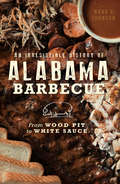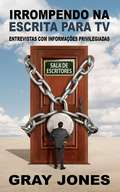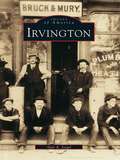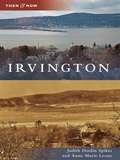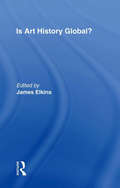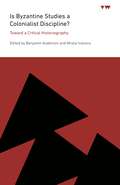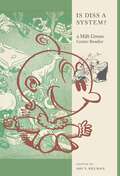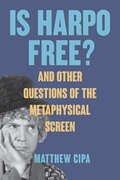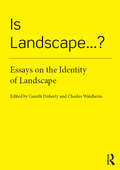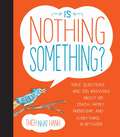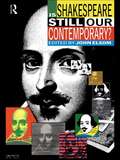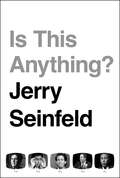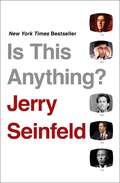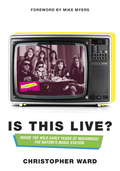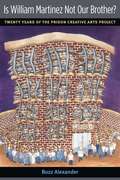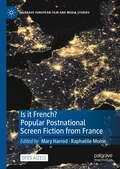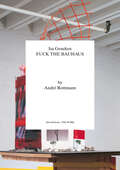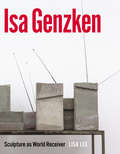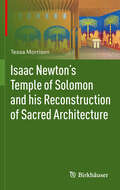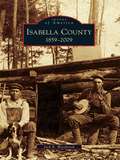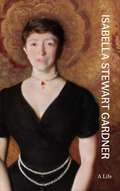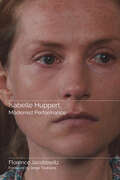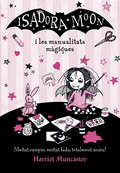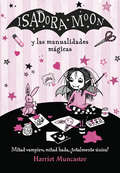- Table View
- List View
Irresistible History of Alabama Barbecue, An: From Wood Pit To White Sauce (American Palate)
by Mark A. JohnsonFrom Muscle Shoals to Mobile, Alabamians enjoy fabulous barbecue at home, at club meetings and at countless eateries. In the 1820s, however, a group of reformers wanted to eliminate the southern staple because politicians used it to entice voters. As the state and nation changed through wars and the civil rights movement, so did Alabama barbecue. Alabama restaurants like Big Bob Gibson’s, Dreamland and Jim ’n Nick’s have earned fans across the country. Mark A. Johnson traces the development of the state’s famous food from the earliest settlement of the state to the rise of barbecue restaurants.
Irrompendo na escrita para TV: entrevistas com informações privilegiadas
by Ana Claudia Antunes Gray Jones"Irrompendo na escrita para TV: entrevistas com informações privilegiadas" rompe mitos sobre como irromper nas salas dos roteiristas de Hollywood, e os substitu com informações privilegiadas e um plano de batalha sólido. Saiba como reconhecer o território, dicas e estratégias daqueles que vieram antes, oportunidades para aproveitar e armadilhas a evitar. Você vai encontrar um mapa de todas as ferramentas que você precisa para começar, e os caminhos tentados e testados para o seu objetivo. Além desses recursos, o livro apresenta transcrições completas de cinco entrevistas no podcast de roteiristas de TV: * Carole Kirschner (Plano de Jogo de Hollywood, Programa de Treinamento de showrunner) * Rick Muirragui (Suits, The Good Guys) * Matt MacLennan (The Listener, Call Me Fitz, Ecstasy de Irvine Welsh) * Aaron Ginsburg (The Finder, The Good Guys, The 100) * Bob DeRosa (Par Perfeito, Crimes do Colarinho Branco, Ligados Pelo Crime) Há muitos insights aplicáveis ao recurso para escrita de filmes também. Se você quiser irromper nesta indústria emocionante, comece aqui!
Irving (Images of America)
by Roxanne Del RioIrving, Texas, was founded in 1903 by two eager individuals, J.O. Schulze and Otis Brown, of the Chicago, Rock Island & Gulf Railway Company. Beginning as an agrarian area of farmland, cotton, and cattle, Irving grew to include industrial facilities while persevering through the financial difficulties resulting from the Civil War and the two world wars. Irving maintained its growth when other cities in the United States could not. Schulze and Brown recognized the importance of utilizing both agricultural and industrial resources in creating and sustaining a successful city. Remnants of early communities, such as Bear Creek, Elm, Estelle, Kit, Sowers, Twin Wells, and Union Bower, can still be identified. Situated between Dallas and Fort Worth, Irving is a robust and thriving city that has greatly contributed to the creation and preservation of Texas history.
Irvington (Images of America)
by Alan A. SiegelLike a cherished old family album, this collection of more than two hundred fascinating photographs of Irvington brings to life people, places, and events of a bygone era. Although the Irvington depicted here--from the time of the Civil War to the 1970s--has changed significantly, its memory remains fresh in the minds of past and present residents alike. Culled from the extensive collections of the Irvington Public Library and Irvington Historical Society, this superb assemblage of images will stimulate many memories. Alan A. Siegel takes us on a delightful journey, starting when Irvington was a tiny village known as Camptown, to the twentieth century when Irvington was transformed almost overnight into a busy industrial and residential suburb of Newark. Shown too are the vital contributions made by successive waves of immigrants who flooded into Irvington during the first half of the twentieth century.
Irvington (Then and Now)
by Judith Doolin Spikes Anne Marie LeoneIrvington, a small village 20 miles north of New York City, overlooks the widest point of the Hudson River. The 19th-century castles and chateaus built along "America's Rhine" have been replaced, yet Main Street remains almost exactly as it was in 1900.
Is Art History Global? (The Art Seminar #Vol. 3)
by James ElkinsThis is the third volume in The Art Seminar, James Elkin's series of conversations on art and visual studies.Is Art History Global? stages an international conversation among art historians and critics on the subject of the practice and responsibility of global thinking within the discipline. Participants range from Keith Moxey of Columbia University to Cao Yiqiang, Ding Ning, Cuautemoc Medina, Oliver Debroise, Renato Gonzalez Mello, and other scholars.
Is Byzantine Studies a Colonialist Discipline?: Toward a Critical Historiography (ICMA Books | Viewpoints)
by Benjamin Anderson and Mirela IvanovaIs Byzantine Studies a colonialist discipline? Rather than provide a definitive answer to this question, this book defines the parameters of the debate and proposes ways of thinking about what it would mean to engage seriously with the field’s political and intellectual genealogies, hierarchies, and forms of exclusion.In this volume, scholars of art, history, and literature address the entanglements, past and present, among the academic discipline of Byzantine Studies and the practice and legacies of European colonialism. Starting with the premise that Byzantium and the field of Byzantine studies are simultaneously colonial and colonized, the chapters address topics ranging from the material basis of philological scholarship and its uses in modern politics to the colonial plunder of art and its consequences for curatorial practice in the present. The book concludes with a bibliography that serves as a foundation for a coherent and systematic critical historiography. Bringing together insights from scholars working in different disciplines, regions, and institutions, Is Byzantine Studies a Colonialist Discipline? urges practitioners to reckon with the discipline’s colonialist, imperialist, and white supremacist history.In addition to the editors, the contributors to this volume include Andrea Myers Achi, Nathanael Aschenbrenner, Bahattin Bayram, Averil Cameron, Stephanie R. Caruso, Şebnem Dönbekci, Hugh G. Jeffery, Anthony Kaldellis, Matthew Kinloch, Nicholas S. M. Matheou, Maria Mavroudi, Zeynep Olgun, Arietta Papaconstantinou, Jake Ransohoff, Alexandra Vukovich, Elizabeth Dospěl Williams, and Arielle Winnik.
Is Diss a System?: A Milt Gross Comic Reader (Goldstein-Goren Series in American Jewish History #16)
by Ari Y. KelmanMilt Gross (1895-1953), a Bronx-born cartoonist and animator, first found fame in the late 1920s, writing comic strips and newspaper columns in the unmistakable accent of Jewish immigrants. By the end of the 1920s, Gross had become one of the most famous humorists in the United States, his work drawing praise from writers like H. L. Mencken and Constance Roarke, even while some of his Jewish colleagues found Gross’ extreme renderings of Jewish accents to be more crass than comical.Working during the decline of vaudeville and the rise of the newspaper cartoon strip, Gross captured American humor in transition. Gross adapted the sounds of ethnic humor from the stage to the page and developed both a sound and a sensibility that grew out of an intimate knowledge of immigrant life. His parodies of beloved poetry sounded like reading primers set loose on the Lower East Side, while his accounts of Jewish tenement residents echoed with the mistakes and malapropisms born of the immigrant experience.Introduced by an historical essay, Is Diss a System? presents some of the most outstanding and hilarious examples of Jewish dialect humor drawn from the five books Gross published between 1926 and 1928—Nize Baby, De Night in de Front from Chreesmas, Hiawatta, Dunt Esk, and Famous Fimmales—providing a fresh opportunity to look, read, and laugh at this nearly forgotten forefather of American Jewish humor.
Is Harpo Free?: And Other Questions of the Metaphysical Screen (SUNY series, Horizons of Cinema)
by Matthew CipaIs Harpo Free? is a lively appreciation of film and television's ability to artistically explore concepts typical of philosophical metaphysics, such as free will, causality, and personal identity. Rather than using films and television programs as vehicles for philosophical arguments, the book instead celebrates the artistic ways in which they give life to various metaphysical concepts and how the artistic expression of these concepts and ideas helps us understand ourselves, the world, and our place within it. Through close analysis of a varied selection of works and their use of narrative, form, and style, Is Harpo Free? exemplifies a novel approach to appreciating the philosophical substance of films and television programs. Films and television programs discussed include A Night at the Opera; Run, Lola, Run; Shane; Harvey; Three Colours: Blue; The Americans; Dark; and Fargo.
Is Landscape... ?: Essays on the Identity of Landscape
by Doherty and Charles WaldheimIs Landscape . . . ? surveys multiple and myriad definitions of landscape. Rather than seeking a singular or essential understanding of the term, the collection postulates that landscape might be better read in relation to its cognate terms across expanded disciplinary and professional fields. The publication pursues the potential of multiple provisional working definitions of landscape to both disturb and develop received understandings of landscape architecture. These definitions distinguish between landscape as representational medium, academic discipline, and professional identity. Beginning with an inquiry into the origins of the term itself, Is Landscape . . . .? features essays by a dozen leading voices shaping the contemporary reading of landscape as architecture and beyond.
Is Nothing Something?: Kids' Questions and Zen Answers About Life, Death, Family, Friendship, and Every thing in Between
by Thich Nhat HanhIn Is Nothing Something? Zen Master Thich Nhat Hanh answers heartfelt, difficult, and funny questions from children of all ages. Illustrated with original full-color artwork by Jessica McClure, Is Nothing Something? will help adults plant the seeds of mindfulness in the young children in their lives. Beginning with the most basic questions, "What is important in life?" and "Why is my brother mean to me?" and progressing through issues that we all wrestle with, such as "How do I know if I really love somebody?", "How long am I going to live?", and "What does God look like?", each page presents a question with a short answer from Thich Nhat Hanh, appropriate for beginning readers to work with on their own. The back of the book has the first complete children’s biography of Thich Nhat Hanh, along with basic, kid-friendly instructions for mindful breathing and mindful walking. Both humorous and profound, Is Nothing Something? is the perfect resource for kids with questions, adults looking to answer them, and anyone with questions of their own.
Is Shakespeare Still Our Contemporary?
by John ElsomFirst published in 2004. Routledge is an imprint of Taylor & Francis, an informa company.
Is This Anything?
by Jerry SeinfeldThe first book in twenty-five years from Jerry Seinfeld features his best work across five decades in comedy. Since his first performance at the legendary New York nightclub &“Catch a Rising Star&” as a twenty-one-year-old student in autumn of 1975, Jerry Seinfeld has written his own material and saved everything. &“Whenever I came up with a funny bit, whether it happened on a stage, in a conversation, or working it out on my preferred canvas – the big yellow legal pad – I kept it in one of those old-school accordion folders,&” Seinfeld writes. &“So I have everything I thought was worth saving from forty-five years of hacking away at this for all I was worth.&” For this book, Jerry Seinfeld has selected his favourite material, organised decade by decade. In page after hilarious page, one brilliantly crafted observation after another, readers will witness the evolution of one of the great comedians of our time and gain new insights into the thrilling but unforgiving art of writing stand-up comedy.
Is This Anything?
by Jerry SeinfeldThe first book in twenty-five years from Jerry Seinfeld features his best work across five decades in comedy. <P><P>Since his first performance at the legendary New York nightclub “Catch a Rising Star” as a twenty-one-year-old college student in fall of 1975, Jerry Seinfeld has written his own material and saved everything. “Whenever I came up with a funny bit, whether it happened on a stage, in a conversation, or working it out on my preferred canvas, the big yellow legal pad, I kept it in one of those old school accordion folders,” Seinfeld writes. “So I have everything I thought was worth saving from forty-five years of hacking away at this for all I was worth.” <P><P>For this book, Jerry Seinfeld has selected his favorite material, organized decade by decade. In page after hilarious page, one brilliantly crafted observation after another, readers will witness the evolution of one of the great comedians of our time and gain new insights into the thrilling but unforgiving art of writing stand-up comedy. <P><P><b>A New York Times Bestseller</b>
Is This Live?: The Nation's Music Station
by Mike Myers Christopher WardFrom former VJ Christopher Ward, Is This Live? captures the pure fun and rock 'n' roll rebellion of the early years of MuchMusic. On August 31, 1984, the Nation's Music Station launched, breaking ground as the Wild (Canadian) West of television--live, gloriously unpredictable, seat-of-the-pants TV, delivered fresh daily. The dream child of TV visionary Moses Znaimer, and John Martin, the maverick creator of The New Music, Much was live and largely improvised, and an entire generation of Canadians grew up watching the VJs and embraced the new music that became the video soundtrack of our lives. The careers of Canadian legends like Blue Rodeo, Corey Hart, Jane Siberry, Bryan Adams, Platinum Blonde, Glass Tiger, Colin James, the Parachute Club, Honeymoon Suite, Barenaked Ladies, Maestro Fresh Wes and Sloan were launched when Much brought them closer to their fans. Much also gave us international acts (Duran, Duran, Tina Turner, Iggy Pop, David Bowie, Madonna, Motorhead, Guns N' Roses, Nirvana, Red Hot Chili Peppers), and covered the second wave of music activism with events like Live Aid and the Amnesty International Human Rights Now! tour. Ranging from Toronto's iconic studio at 299 Queen Street West, to Vancouver's MuchWest, MuchMusic's programming travelled across Canada and connected the Canadian music scenes in an unprecedented way. With stories of the bands, the music, the videos, the specialty shows, the style and the improvisational approach to daily broadcast life at Much, Is This Live? is told by the people who were there--the colourful cast of on-air VJs, the artists who found their way into our living rooms of the nation as never before, and the people behind the cameras. As our tour guide to the first decade at MuchMusic Christopher Ward delivers a full-on dose of pop culture nostalgia from the 1980s and '90s, when the music scene in Canada changed forever.From the Trade Paperback edition.
Is William Martinez Not Our Brother?: Twenty Years of the Prison Creative Arts Project
by Buzz AlexanderA prison arts program attempts to reverse the trends of incarceration in America
Is it French? Popular Postnational Screen Fiction from France (Palgrave European Film and Media Studies)
by Mary Harrod Raphaëlle MoineThis book investigates the recently accelerated phenomenon of mainstream French film and serial television’s remarkable popularity not only within but – more novelly for European audiovisual narratives – outside the domestic context. Treating changes that have taken place in France's production landscape during the mass rollout of global streaming platforms as revelatory of broader tendencies in media production and circulation in Europe and beyond, the collection explores emergent influential players (Omar Sy, Camille Cottin, Alexandre Aja and Fanny Herrero), companies such as Netflix and Gaumont, and new genres, identities and representations on screen. It thus draws together a body of new research by international experts in French and European media production to analyse popular film and television series from France through a postnational lens with regards to both economic and institutional norms and to culture as a whole.
Isa Genzken: Fuck the Bauhaus (Afterall Books / One Work)
by Andre RottmanA strikingly original analysis of Isa Genzken&’s move towards merging sculptural and architectural morphologies into a trailblazing practice of contemporary assemblage.Fuck the Bauhaus, a series of audacious architectural models for future high-rise buildings in Manhattan, marks a poetic and provocative shift in Isa Genzken&’s artistic oeuvre. Made in the year 2000, out of quotidian objects and cheap materials foraged in the streets and stores of New York, these sculptural assemblages depart from the German artist&’s &‘post-Minimalist&’ works begun in the 1970s. The earlier works conjured the haunting spectres of catastrophe, destruction and failed utopia, as well as the potential for freedom amidst the ruins of post-War reconstruction culture.Analysing Genken&’s post–2000 penchant for appropriation, collage and montage, André Rottmann draws on the writings of Deleuze and Guattari, Bruno Latour and other theorists of "assemblage," to show how her &‘late style&’ is not a return to (neo-)avant-garde traditions but a powerful reimagining of them for the contemporary moment.
Isa Genzken: Sculpture as World Receiver
by Lisa LeeThe work of German sculptor Isa Genzken is brilliantly receptive to the ever-shifting conditions of modern life. In this first book devoted to the artist, Lisa Lee reflects on Genzken’s tendency to think across media, attending to sculptures, photographs, drawings, and films from the entire span of her four-decade career, from student projects in the mid-1970s to recent works seen in Genzken’s studio. Through penetrating analyses of individual works as well as archival and interview material from the artist herself, Lee establishes four major themes in Genzken’s oeuvre: embodied perception, architecture and built space, the commodity, and the body. Contextualizing the sculptor’s engagement with fellow artists, such as Joseph Beuys and Bruce Nauman, Lee situates Genzken within a critical and historical framework that begins in politically fraught 1960s West Germany and extends to the globalized present. Here we see how Genzken tests the relevance of the utopian aspirations and formal innovations of the early twentieth century by submitting them to homage and travesty. Sure to set the standard for future studies of Genzken’s work, Isa Genzken is essential for anyone interested in contemporary art.
Isaac Newton's Temple of Solomon and his Reconstruction of Sacred Architecture
by Tessa MorrisonThis book is about a side of Isaac Newton's character that has not been examined - Isaac Newton as architect as demonstrated by his reconstruction of Solomon's Temple. Although it is well known that Isaac Newton worked on the Temple, and this is mentioned in most of his biographies and in articles on the religious aspects of this work, however, there is no research on Newton's architectural work. This book not only recreates Newton's reconstruction of the Temple but it also considers how his work on the Temple interlinks with his other interests of science, chronology, prophecy and theology. In addition the book contains the first translation of Introduction to the Lexicon of the Prophets, Part two: About the appearance of the Jewish Temple commonly known by its call name Babson 0434. This work will appeal not only to scholars of science and architectural history but also to scholars of the seventeenth and eighteenth centuries' history of ideas.
Isabella County: 1859 - 2009 (Images of America)
by Jack R. WestbrookAn ancient revered gathering and hunting place for Chippewa Indians becomes the modern home to one of the nation's largest Native American tribal-owned casino/resort complexes. A rough-and-tumble timbering center sees Michigan's first lumber millionaire plat a town, dedicating five acres for a county seat. Residents organize a private normal school for teacher training, to become Michigan's fourth-largest university, Central Michigan University. Hardworking immigrants carve farms, villages, and towns from the timbered-out wilderness near the center of the Michigan Lower Peninsula "mitten." From harvesting lumber above the ground to harvesting petroleum below the ground, the area ushers in an oil boom on time to be saved from the financial tribulations of the Great Depression. Incorporated in 1859, during the turbulent times just ahead of the Civil War and birth year of the United States oil industry, the area becomes a modern-day commerce center. This is the saga of Isabella County, told as the county celebrates 150 years of economic and cultural diversity.
Isabella Stewart Gardner: A Life
by Diana Seave Greenwald Nathaniel SilverA major new biography of legendary art collector and philanthropist Isabella Stewart GardnerIsabella Stewart Gardner (1840–1924) assembled an extraordinary collection of art from diverse cultures and eras—and built a Venetian-style palazzo in Boston to share these exquisite treasures with the world. But her life and work remains shrouded in myth. Separating fiction and fact, this book paints an unforgettable portrait of Gardner, drawing on her substantial personal archive and including previously unpublished findings to offer new perspectives on her life and her construction of identity.Nathaniel Silver and Diana Seave Greenwald shed new light on Gardner's connections to minority communities in Boston, her views on suffrage and other issues of the day, the sources of her and her husband’s wealth, and her ties to politicians, writers, and artists. What emerges is a multifaceted portrait of a trailblazing collector and patron of the arts—from Italian Renaissance paintings to Chinese antiquities—who built a museum unprecedented in its curatorial vision.Beautifully illustrated, this book challenges any portrayal of Gardner as a straightforward feminist hero, revealing instead an exceptional, complex woman who created a legendary museum and played a vibrant and influential role in the art world.Distributed for the Isabella Stewart Gardner Museum
Isabelle Huppert, Modernist Performance
by Florence JacobowitzIsabelle Huppert's modernist performance style illustrated through detailed readings of key films, demonstrating her immense social impact. Isabelle Huppert's oeuvre constitutes perhaps the most significant feminist body of work to have emerged in the wake of the second wave of the women's movement, a period of intense social change. The emphasis on autonomy, or the "anti-victim," which comes to define Huppert's persona, is supported by a modernist style of performance. Huppert's refusal to surrender herself to the viewer through a character one fully knows disrupts the expectations of identification, inviting a distinctive approach to her characters. By creating a character informed by who she is, Huppert signals a process usually kept invisible. Huppert's performances invite an active form of critical reading, directing one to fill in gaps and consider the character in relation to the social world. The directors she works with welcome her collaboration; Huppert's performance, in conjunction with the mise-en-scène, generic conventions, and the film in its totality, creates the "meaning" of the film. Thus, Isabelle Huppert, Modernist Performance demonstrates its premise through close readings considering how performance must be read in tandem with the whole.
Isadora Moon i les manualitats màgiques (La Isadora Moon #Volumen)
by Harriet MuncasterEl llibre de manualitats de la Isadora Moon! La Isadora Moon és especial perquè és diferent. Vols ser com ella? Amb aquest llibre de manualitats podràs transformar-te en una fada o en un vampir i crear els accessoris més magnífics i increïbles. Dissenya i crea la teva pròpia vareta màgica, el teu diari de vampir, una esgarrifosa invitació d'aniversari o al teu propi rat-penat mascota.
Isadora Moon y las manualidades mágicas (Isadora Moon #Volumen)
by Harriet Muncaster¡El libro de manualidades de Isadora Moon! Isadora Moon es especial porque es diferente. ¿Quieres ser como ella? Con este libro de manualidades podrás transformarte en hada o en vampiro y crear los accesorios más mágicos e increíbles. Diseña tu propia varita mágica, tu diario de vampiro, una espeluznante invitación de cumpleaños o a tu propio murciélago-mascota.
